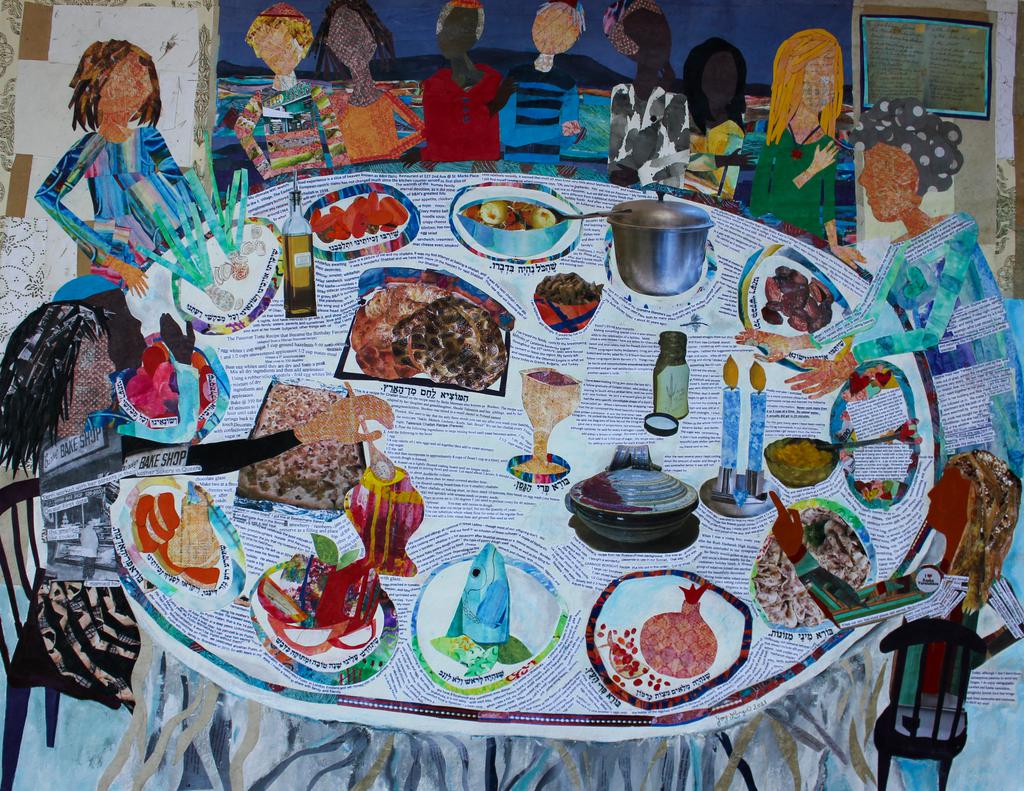
Passover Torte with Susanne Fruchter
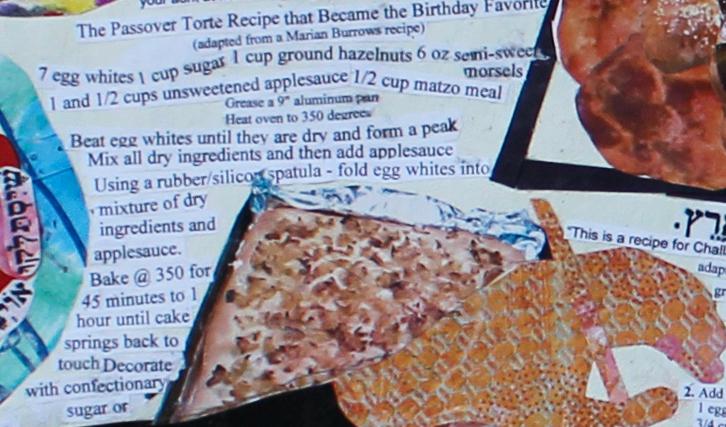
נֵימָא מְסַיַּיע לֵיהּ: הַסּוּפְגָּנִין וְהַדּוּבְשָׁנִין וְהָאִיסְקְרִיטִין, אָדָם מְמַלֵּא כְּרֵיסוֹ מֵהֶן, וּבִלְבַד שֶׁיֹּאכַל כְּזַיִת מַצָּה בָּאַחֲרוֹנָה.
The Gemara proposes: Let us say that the Tosefta supports Shmuel’s ruling: With regard to unleavened sponge cakes, cakes fried in oil and honey, and honey cakes, a person may fill his stomach with them on Passover night, provided that he eats an olive-bulk of matza after all that food.
The Passover Torte Recipe that Became the Birthday Favorite (adapted from a Marian Burrows recipe):
7 egg whites
1 cup sugar
1 cup ground hazelnuts
6 oz semi-sweet morsels
1 and 1/2 cups unsweetened applesauce
1/2 cup matzo meal
Grease a 9" aluminum pan
Heat oven to 350 degrees
Beat egg whites until they are dry and form a peak
Mix all dry ingredients and then add applesauce
Using a rubber/silicone spatula - fold egg whites into mixture of dry ingredients and applesauce.
Bake @ 350 for 45 minutes to 1 hour until cake springs back to touch.
Decorate with confectionary sugar or chocolate glaze
Make two at a time -freezes well...or after cakes are cool use strawberry / raspberry jam or preserve as a filling and place one on top of the other as a double layer cake and frost with glaze.
Sephardic Foods with Shirley Gabel
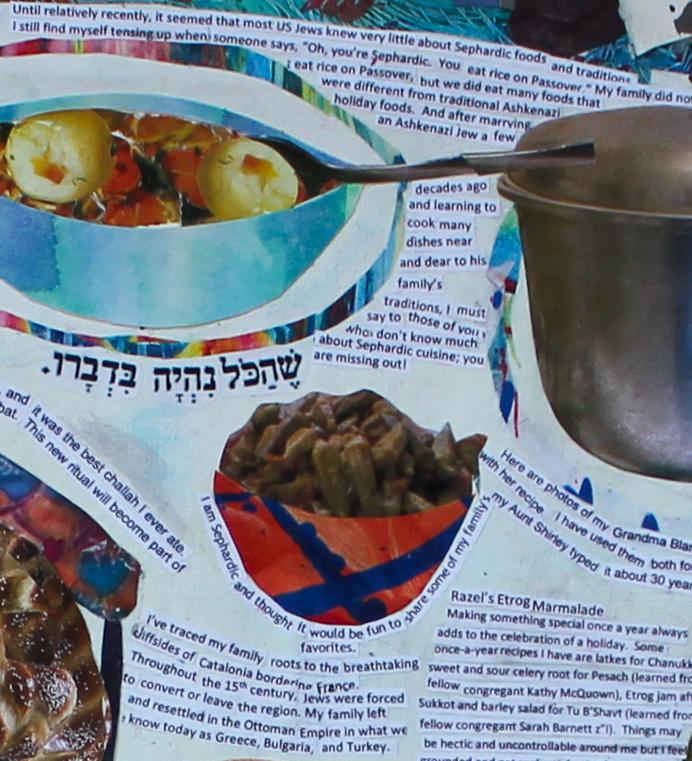
עַל כֻּלָּם אִם אָמַר שֶׁהַכֹּל נִהְיָה, יָצָא:
And over all food items, one who recited: By whose word all things came to be, fulfilled his obligation.
"Until relatively recently, it seemed that most US Jews knew very little about Sephardic foods and traditions. I still find myself tensing up when someone says, “Oh, you’re Sephardic. You eat rice on Passover.” My family did not eat rice on Passover, but we did eat many foods that were different from traditional Ashkenazi holiday foods. And after marrying an Ashkenazi Jew a few decades ago and learning to cook many dishes near and dear to his family’s traditions, I must say to those of you who don’t know much about Sephardic cuisine; you are missing out!
I’ve traced my family roots to the breathtaking cliffsides of Catalonia bordering France. Throughout the 15th century, Jews were forced to convert or leave the region. My family left and resettled in the Ottoman Empire in what we know today as Greece, Bulgaria, and Turkey. My cousins and siblings all continue to speak Ladino – though most of our offspring don’t. We all take cooking very seriously, and our food is an infusion of these cultures.
A staple of Sephardic cuisine is borekas - whether it is for desayuno after Shabbat services or a special occasion. Borekas are these flaky pastry dough treats – the type of pastry dough used varies as well as the filling for the occasion. They could be filled with cheeses, eggplant, and cheese, spinach and cheese, or meat and much more depending on the cook and meal.
In the photos [below], you’ll see eggs poached in tomato, pepper, and feta cheese and sprinkled with parsley. Yum! My mom would make this for us when we were all home and weren’t rushing to go somewhere. We have it for brunch and sometimes even dinner. It is similar to Shakshuka – a popular dish today in that both use tomatoes and eggs, but unlike Shakshuka, it is not spicy. With each bite, different flavors burst in your mouth. It’s best when served with warm bread or pita on a cold day!"
Chicken Fat and Gribenes with Ettie Ward
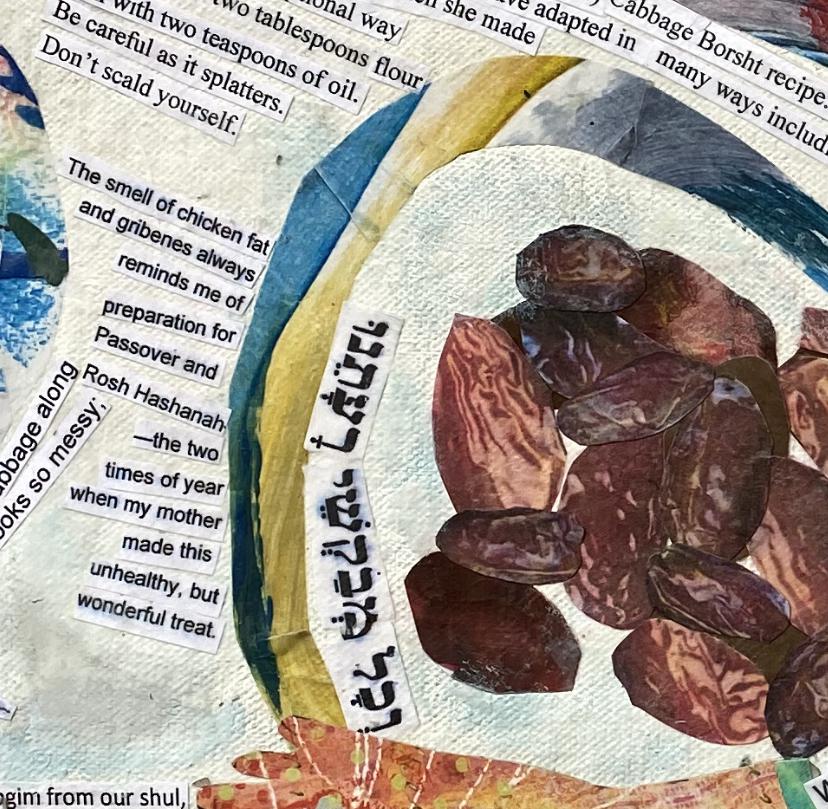
"The smell of chicken fat and gribenes always reminds me of preparation for Passover and Rosh Hashanah—the two times of year when my mother made this unhealthy, but wonderful treat."
Challah
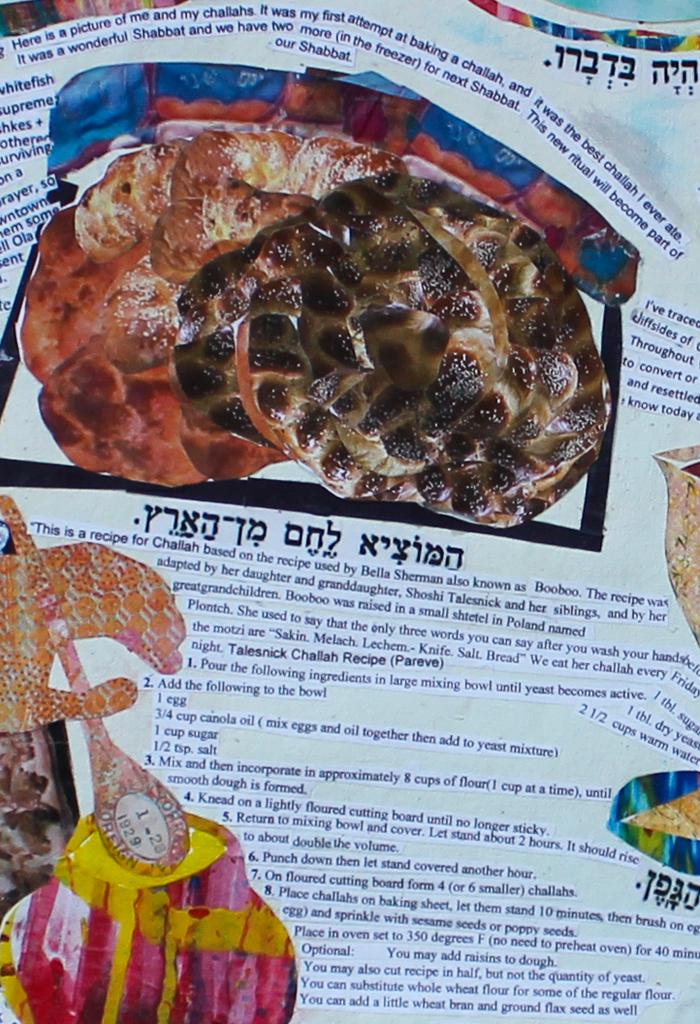
שֶׁעַל הַפַּת הוּא אוֹמֵר הַמּוֹצִיא לֶחֶם מִן הָאָרֶץ
as over bread one recites: Who brings forth bread from the earth.
רַב הוּנָא בְּשֵׁם רַב מַתְנָה אָמַר, בִּזְכוּת שְׁלשָׁה דְּבָרִים נִבְרָא הָעוֹלָם, בִּזְכוּת חַלָּה, וּבִזְכוּת מַעַשְׂרוֹת, וּבִזְכוּת בִּכּוּרִים, וּמַה טַּעַם, בְּרֵאשִׁית בָּרָא אֱלֹהִים, וְאֵין רֵאשִׁית אֶלָא חַלָּה, שֶׁנֶּאֱמַר (במדבר טו, כ): רֵאשִׁית עֲרִסֹתֵיכֶם, אֵין רֵאשִׁית אֶלָּא מַעַשְׂרוֹת, הֵיךְ דְּאַתְּ אָמַר (דברים יח, ד): רֵאשִׁית דְּגָנְךָ, וְאֵין רֵאשִׁית אֶלָּא בִּכּוּרִים, שֶׁנֶּאֱמַר (שמות כג, יט): רֵאשִׁית בִּכּוּרֵי אַדְמָתְךָ וגו'.
Rabbi Hunna said in the name of Rabbi Matanah: The world was created in the merit of three things--challah, tithes, and first fruits. The verse "In the beginning God created" refers to challah, as it says (Numbers 15:20): "The beginning of your doughs." It also refers to tithes, as it says (Deuteronomy 18:4): "The beginning of your grains." It also refers to first fruits, as it says (Exodus 23:19): "The beginning of the fruits of the land."
Challah with Matthew Levin

Challah with Mark Gothelf
"Here is a picture of me and my challahs. It was my first attempt at baking a challah, and it was the best challah I ever ate. It was a wonderful Shabbat and we have two more (in the freezer) for next Shabbat. This new ritual will become part of our Shabbat."
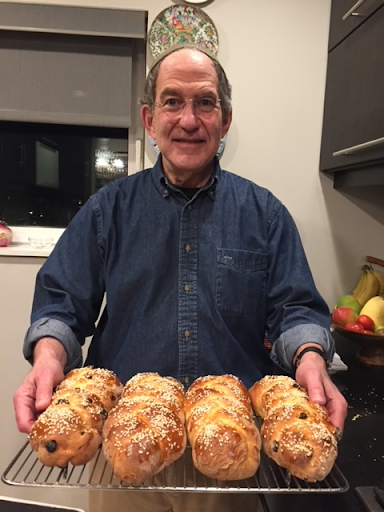
Challah with Debbie Greenberg
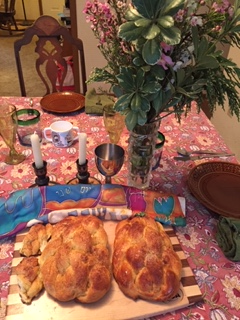
Challah with Rabbi Barry Katz and Shoshi Talesnick
This is a recipe for Challah based on the recipe used by Bella Sherman also known as Booboo. The recipe was adapted by her daughter and granddaughter, Shoshi Talesnick and her siblings, and by her greatgrandchildren. Booboo was raised in a small shtetel in Poland named Plontch. She used to say that the only three words you can say after you wash your hands before the motzi are “Sakin. Melach. Lechem.- Knife. Salt. Bread” We eat her challah every Friday night.
Talesnick Challah Recipe (Pareve)
1. Pour the following ingredients in large mixing bowl until yeast becomes active.
2 1/2 cups warm water
1 tbl. dry yeast
1 tbl. sugar
2. Add the following to the bowl
1 egg
3/4 cup canola oil ( mix eggs and oil together then add to yeast mixture)
1 cup sugar
1/2 tsp. salt
3. Mix and then incorporate in approximately 8 cups of flour(1 cup at a time), until smooth dough is formed.
4. Knead on a lightly floured cutting board until no longer sticky.
5. Return to mixing bowl and cover. Let stand about 2 hours. It should rise to about double the volume.
6. Punch down then let stand covered another hour.
7. On floured cutting board form 4 (or 6 smaller) challahs.
8. Place challahs on baking sheet, let them stand 10 minutes, then brush on egg wash (one beaten egg) and sprinkle with sesame seeds or poppy seeds.
Place in oven set to 350 degrees F (no need to preheat oven) for 40 minutes.
Optional: You may add raisins to dough.
You may also cut recipe in half, but not the quantity of yeast.
You can substitute whole wheat flour for some of the regular flour.
You can add a little wheat bran and ground flax seed as well
B&H Dairy with Arthur Levy
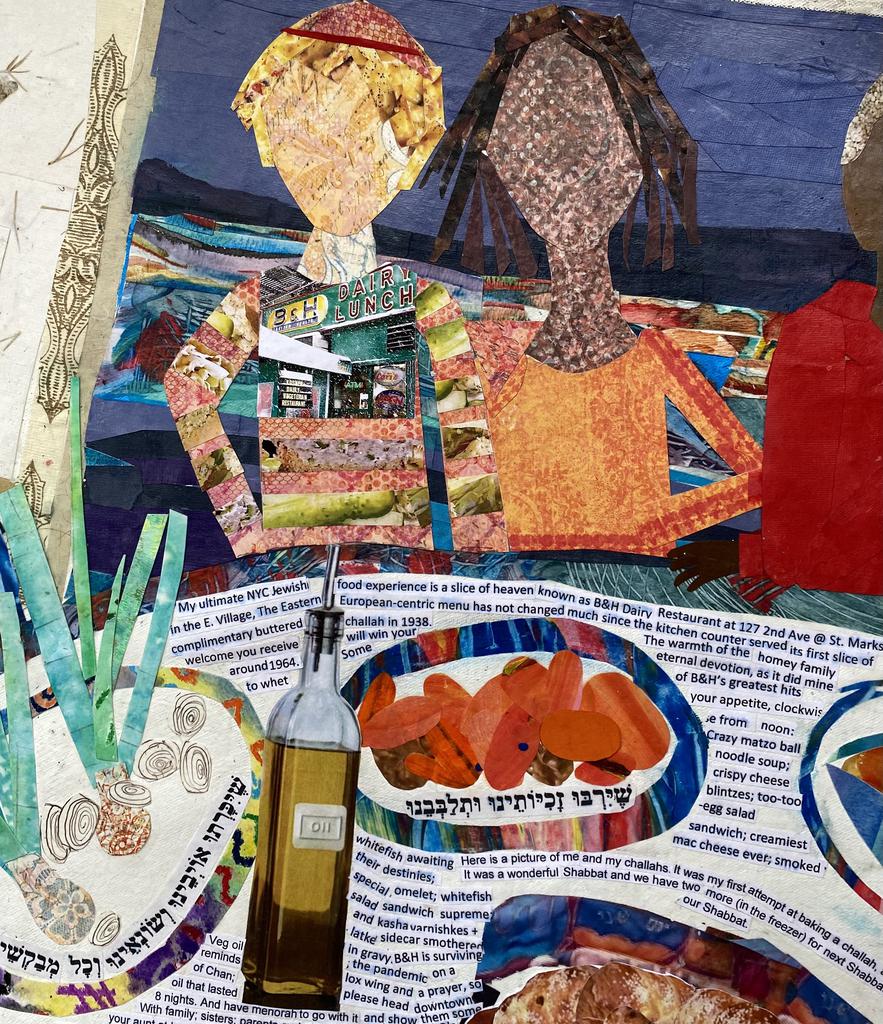
"My ultimate NYC Jewish food experience is a slice of heaven known as B&H Dairy Restaurant at 127 2nd Ave @ St. Marks Place in the E. Village, The Eastern European-centric menu has not changed much since the kitchen counter served its first slice of complimentary buttered challah in 1938. The warmth of the homey family welcome you receive will win your eternal devotion, as it did mine around 1964. Some of B&H’s greatest hits to whet your appetite, clockwise from noon: Crazy matzohball noodle soup; crispy cheese blintzes; too-too-egg salad sandwich; creamiest mac cheese ever; smoked whitefish awaiting their destinies; XXX-rated special omelette; whitefish salad sandwich supreme; and kasha varnishkes + latke sidecar smothered in gravy. B&H is surviving the pandemic on a lox wing and a prayer, so please head downtown and show them some love, and tell Ola that I sent you."
A Grandmother's Cooking with Bob Jacobs
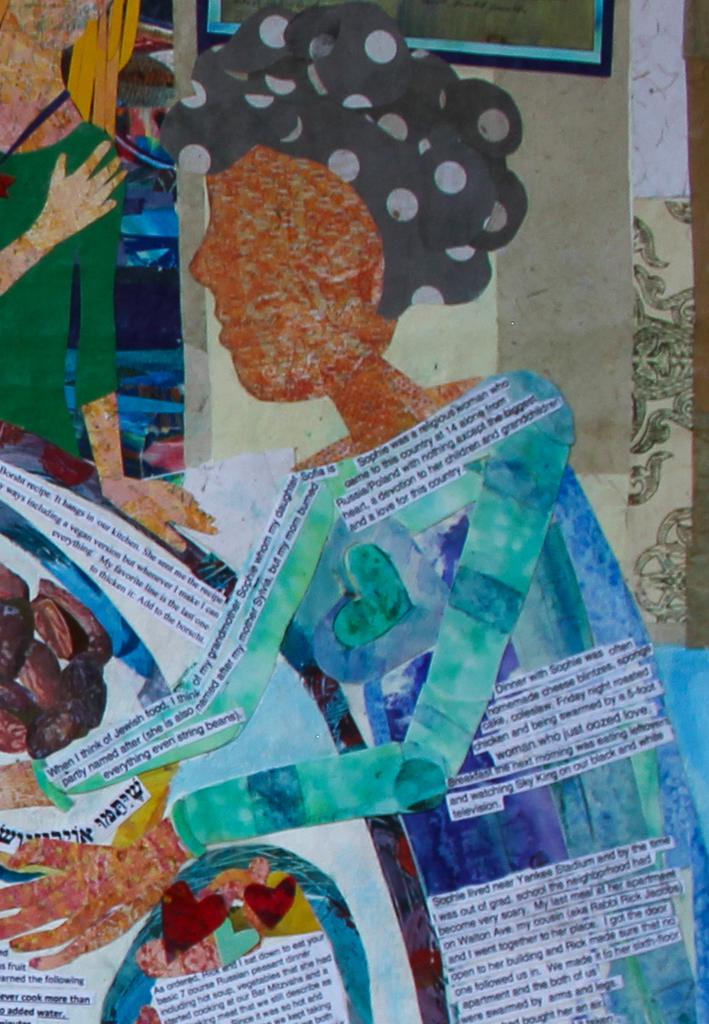
"When I think of Jewish food I think of my grandmother Sophie whom my daughter Sofia is partly named after (she is also named after my mother Sylvia, but my mom burned everything even string beans). Sophie was a religious woman who came to this country at 14 alone from Russia/Poland with nothing except the biggest heart, a devotion to her children and grandchildren and a love for this country. Dinner with Sophie was often homemade cheese blintzes, sponge cake, cole slaw, Friday night roasted chicken and being swarmed by a 5 foot 1 woman who just oozed love. Breakfast the next morning was eating leftovers and watching Sky King on our black and white television.
Sophie lived near Yankee Stadium and by the time I was out of grad. school the neighborhood had become very scary. My last meal at her apartment on Walton Ave. my cousin (aka Rabbi Rick Jacobs) and I went together to her place. I got the door open to her building and Rick made sure that no one followed us in. We made it to her sixth floor apartment and the both of us were swarmed by arms and legs. My uncle had bought her an air conditioner but she had it taken out of the window because it made too much noise. That was amazing since she was hard of hearing and it was the summer and it was like eating in a steam bath.
As ordered, Rick and I sat down to eat your basic 7 course Russian peasant dinner including hot soup, vegetables that she had started cooking at our Bar Mitzvahs and a gray looking meat that we still describe as mystery meat. Since it was so hot and humid, after each course we kept taking more and more clothes off until we both were sitting in Sophie’s dining room in our gotka’s. I still remember Sophie telling us after each course and with less and less clothes on how much her grandsons loved her. This was unquestionably true, As always dinner ended with her classic sponge cake and being sent home with a bag full of sponge cake, apple sauce with a swirl of strawberry jello in it, a jar of cole slaw and a wealth of smiles and hugs. Honestly, the blintzes and the sponge cake were great and I wish I knew the recipes but it was Sophie and her stories and feeling totally safe with her that made it so special."
Cabbage Borscht
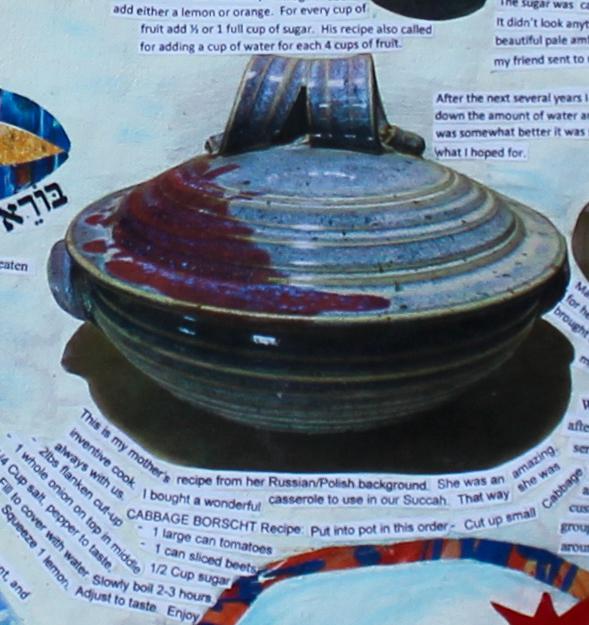
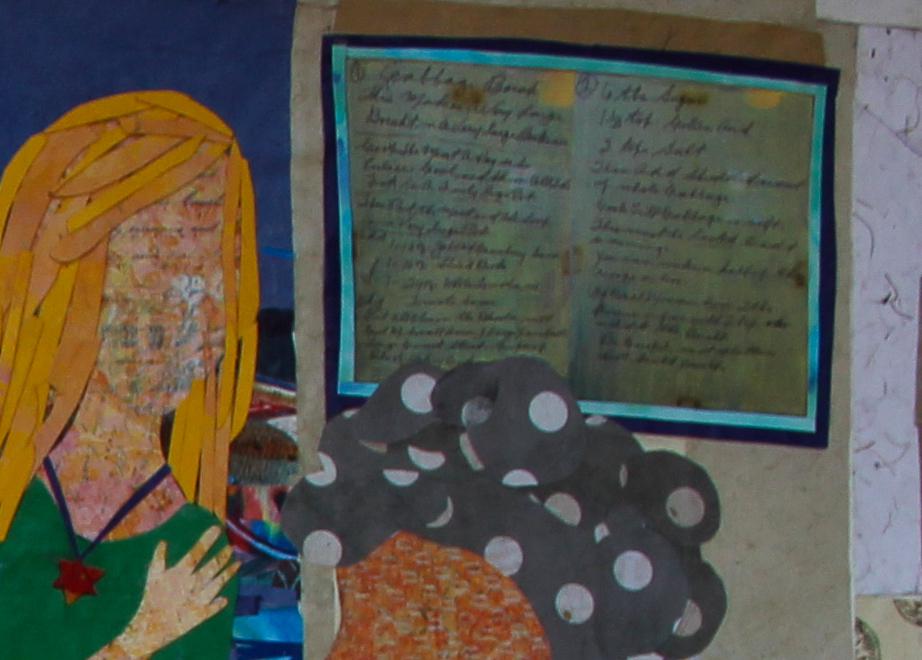
Cabbage for nourishment and beets for healing. Is cabbage good for nourishment and not for healing? Wasn’t it taught: Six things cure the ill person of his disease and their cure is a cure, and these are: Cabbage, beets, chamomile water, honey, stomach, heret, and liver. Rather, say: Cabbage is also for sustenance!
Cabbage Borscht with Marj Tolub
This is my mother’s recipe from her Russian/Polish background. She was an amazing, inventive cook. I bought a wonderful casserole to use in our Succah. That way she was always with us.
Recipe:
Put into pot in this order
- Cut up small Cabbage
- 2lbs flanken cut-up
- 1 large can tomatoes
- 1 can sliced beets
- 1 whole onion on top in middle
- 1/4 Cup salt, pepper to taste, 1/2 Cup sugar
- Fill to cover with water.
Slowly boil 2-3 hours. Squeeze 1 lemon. Adjust to taste. Enjoy
Cabbage Borscht with Barry Katz
"Below* is my grandmother, Sarah Gordon Katz’ (aka Bubby Katz’s) Cabbage Borsht recipe. It hangs in our kitchen. She sent me the recipe this handwritten version when I was in college. I have adapted in many ways including a vegan version but whenever I make I can hear her voice and feel the love with which she made everything.
My favorite line is the last one where she describes an optional way to thicken it:
You can brown two tablespoons flour in a pan with two teaspoons of oil. Add to the borscht.
Be careful as it splatters. Don’t scald yourself."
*See above in the frame in the art detail.
Oil with Daniel Gallent
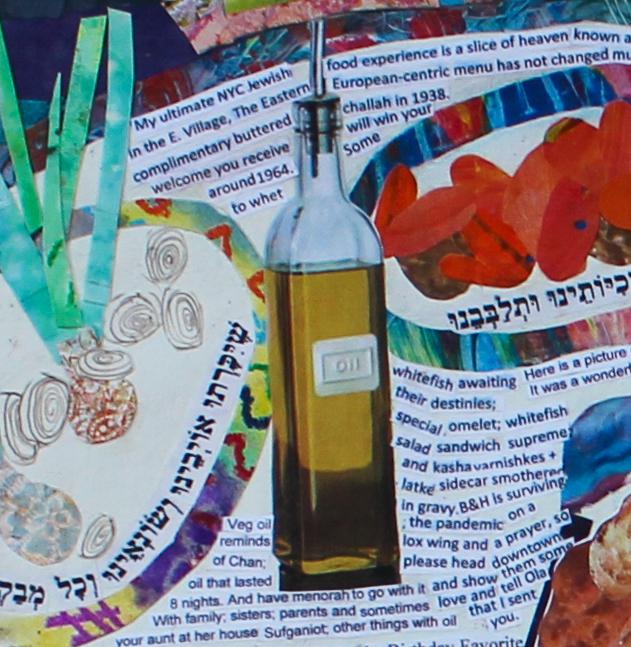
מַאי חֲנוּכָּה? דְּתָנוּ רַבָּנַן: בְּכ״ה בְּכִסְלֵיו יוֹמֵי דַחֲנוּכָּה תְּמָנְיָא אִינּוּן דְּלָא לְמִסְפַּד בְּהוֹן וּדְלָא לְהִתְעַנּוֹת בְּהוֹן. שֶׁכְּשֶׁנִּכְנְסוּ יְווֹנִים לַהֵיכָל טִמְּאוּ כׇּל הַשְּׁמָנִים שֶׁבַּהֵיכָל. וּכְשֶׁגָּבְרָה מַלְכוּת בֵּית חַשְׁמוֹנַאי וְנִצְּחוּם, בָּדְקוּ וְלֹא מָצְאוּ אֶלָּא פַּךְ אֶחָד שֶׁל שֶׁמֶן שֶׁהָיָה מוּנָּח בְּחוֹתָמוֹ שֶׁל כֹּהֵן גָּדוֹל, וְלֹא הָיָה בּוֹ אֶלָּא לְהַדְלִיק יוֹם אֶחָד. נַעֲשָׂה בּוֹ נֵס וְהִדְלִיקוּ מִמֶּנּוּ שְׁמוֹנָה יָמִים.
When the Greeks entered the Sanctuary they defiled all the oils that were in the Sanctuary. And when the Hasmonean monarchy overcame them and emerged victorious over them, they searched and found only one cruse of oil that was placed with the seal of the High Priest. And there was there to light only one day. A miracle occurred and they lit from it eight days.
"Veg oil reminds of Chanukah; oil that lasted 8 nights. And have menorah to go with it
With family; sisters; parents and sometimes your aunt at her house"
Etrog Marmalade with Razel Kessler
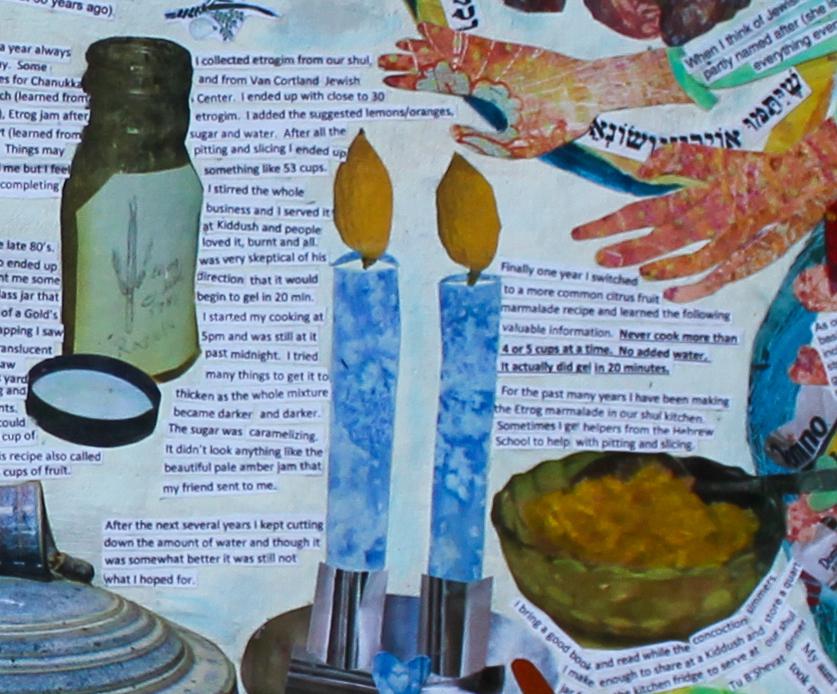
Pletzel (Onion Board) with Vivian Weintraub
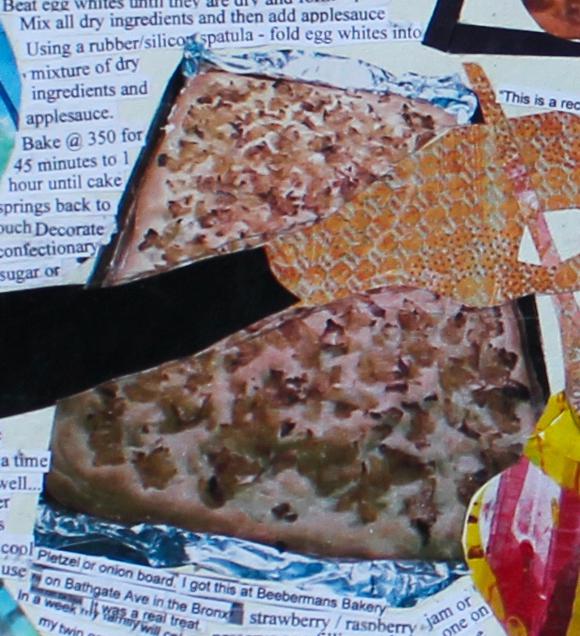
אָמַר רָבָא בַּר בַּר חָנָה אָמַר רַבִּי יוֹחָנָן מִשְּׁמֵיהּ דְּרַבִּי יְהוּדָה בְּרַבִּי אִילְעַי: אֱכוֹל בָּצָל וְשֵׁב בַּצֵּל,
Rabba bar bar Ḥana said that Rabbi Yoḥanan said, citing Rabbi Yehuda, son of Rabbi Elai: Eat an onion [batzal] and sit in the shade [batzel].
"I got this at Beebermans Bakery on Bathgate Ave in the Bronx. It was a real treat.
On rare occasions I had this as a kid."
Latkes with Judy Matthews

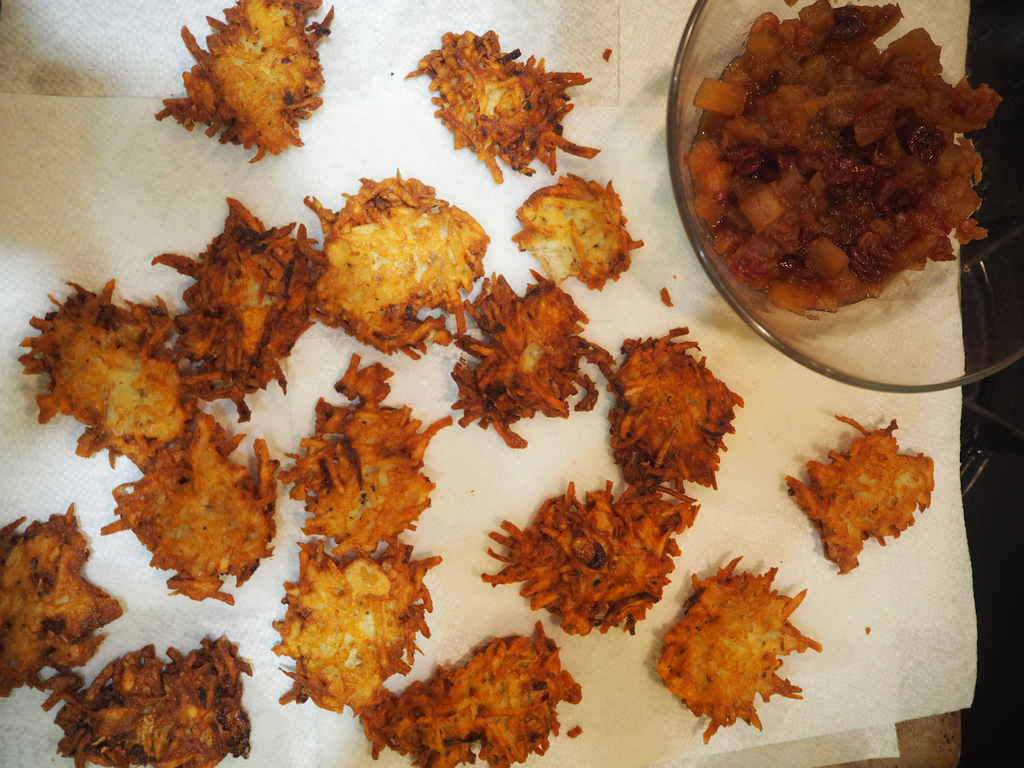
Stuffed Cabbage with Dianne Meranus
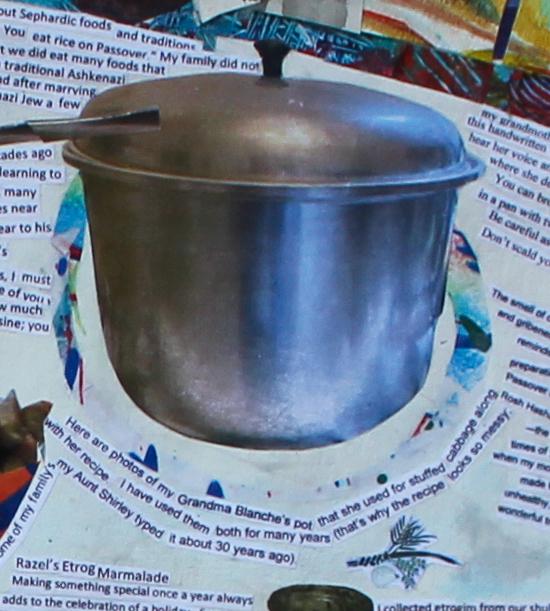
וְהָיָ֤ה הַסִּירוֹת֙ בְּבֵ֣ית יְהֹוָ֔ה כַּמִּזְרָקִ֖ים לִפְנֵ֥י הַמִּזְבֵּֽחַ׃ (כא) וְ֠הָיָ֠ה כׇּל־סִ֨יר בִּירוּשָׁלַ֜͏ִם וּבִיהוּדָ֗ה קֹ֚דֶשׁ לַיהֹוָ֣ה צְבָא֔וֹת וּבָ֙אוּ֙ כׇּל־הַזֹּ֣בְחִ֔ים וְלָקְח֥וּ מֵהֶ֖ם וּבִשְּׁל֣וּ בָהֶ֑ם
The metal pots in the House of the LORD shall be like the basins before the altar; (21) indeed, every metal pot in Jerusalem and in Judah shall be holy to the LORD of Hosts. And all those who sacrifice shall come and take of these to boil [their sacrificial meat] in
"Here are photos of my Grandma Blanche’s pot that she used for stuffed cabbage along with her recipe. I have used them both for many years (that’s why the recipe looks so messy; my Aunt Shirley typed it about 30 years ago)."
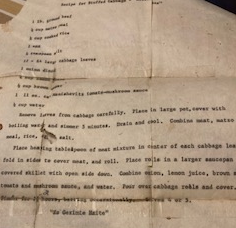
Hamantashn with Ellie Schweber
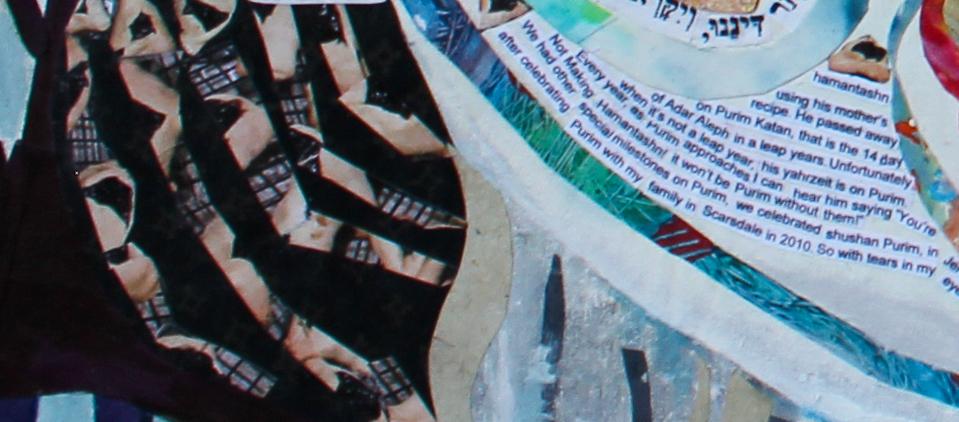
(22) the same days on which the Jews enjoyed relief from their foes and the same month which had been transformed for them from one of grief and mourning to one of festive joy. They were to observe them as days of feasting and merrymaking, and as an occasion for sending gifts to one another and presents to the poor.
Hamantashn with Ellie Schweber
In a week, my family will celebrate the bnot mitzvah of my twin granddaughters, Natalie and Alexandra. I remember the joy that my husband Ken felt the first time he held them. Unfortunately he left us in 2014. Purim was his favorite holiday. He always made a big deal about making hamantashn using his mother’s recipe. He passed away on Purim Katan, that is the 14 day of Adar Aleph in a leap years. Unfortunately, when it’s not a leap year, his yahrzeit is on Purim. Every year, as Purim approaches, I can hear him saying “You’re Not Making Hamantashn! it won’t be Purim without them!”
We had other special milestones on Purim, we celebrated shushan Purim, in Jerusalem, we celebrated Purim in London England and we moved into our apartment in Riverdale after celebrating Purim with my family in Scarsdale in 2010.
So with tears in my eyes, I make a batch to share with family and friends.
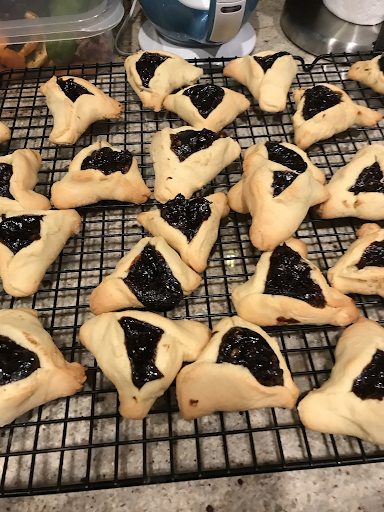
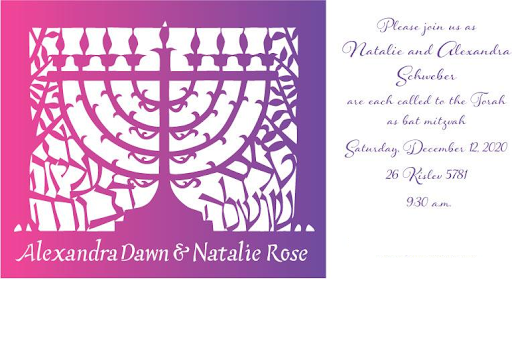
Kasha, Kasha Varnishkes, and Kasha Knish Logs
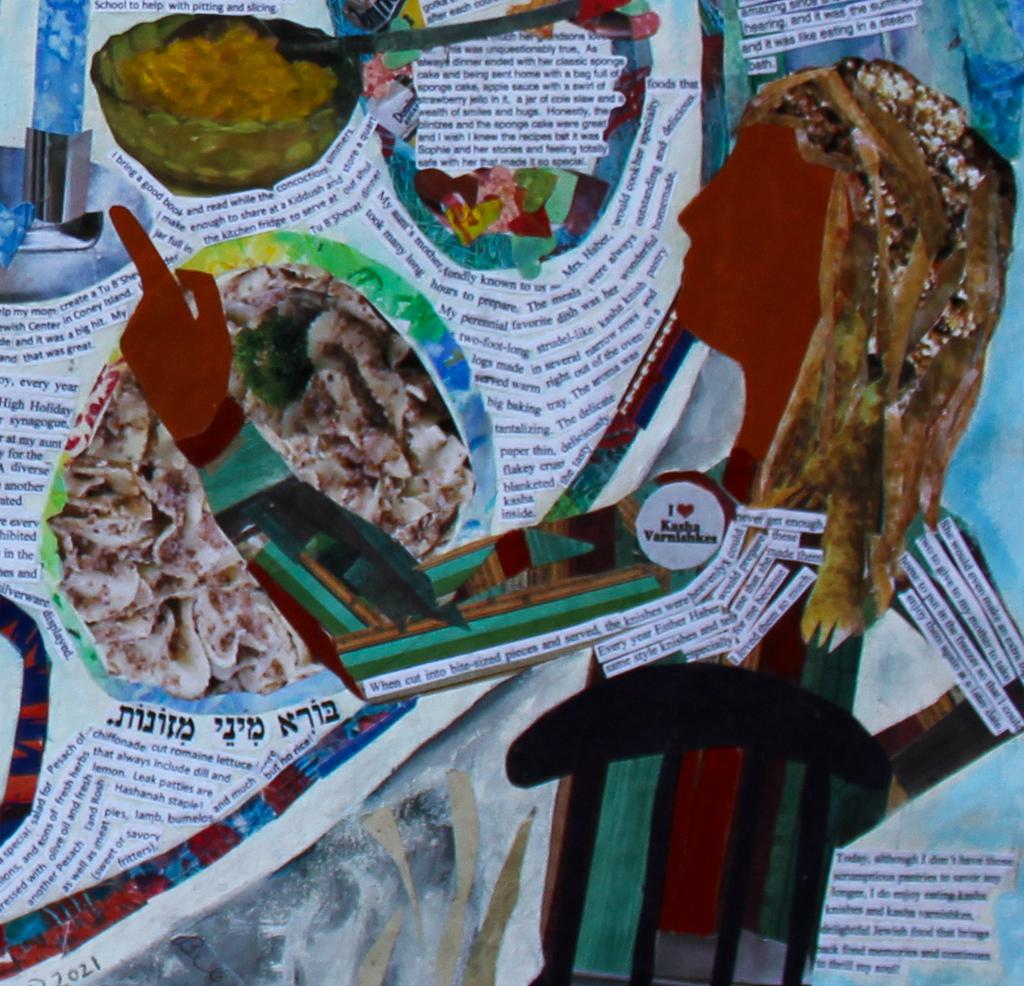
אָמַר רַבִּי יַעֲקֹב בַּר אִידִי אָמַר רַבִּי חֲנִינָא: כׇּל שֶׁהוּא מֵחֲמֵשֶׁת הַמִּינִין, בַּתְּחִלָּה — מְבָרֵךְ עָלָיו ״בּוֹרֵא מִינֵי מְזוֹנוֹת״
Rabbi Ya’akov bar Idi said that Rabbi Ḥanina said: Anything that is from the five species of grain, at the start, one recites over it: Who creates the various kinds of nourishment
Matthew Rosenzweig's Kasha Knish Logs and Kasha Vanishkes
"When I was a young boy, every year after the Rosh Hashanah High Holiday services concluded in our synagogue, the family would gather at my aunt and uncle’s house nearby for the customary holiday lunch. A diverse group of relatives joined one another around the beautifully decorated dining room table where every place setting exhibited elegance in the dishes and silverware displayed.
My aunt’s mother, fondly known to us as Mrs. Haber, would cook her specialty foods that took many long hours to prepare. The meals were always outstanding and delicious. My perennial favorite dish was her wonderful homemade, two-foot-long strudel-like kasha knish pastry logs made in several narrow rows and served warm right out of the oven on a big baking tray. The aroma was tantalizing. The delicate paper thin, deliciously flakey crust blanketed the tasty kasha inside. When cut into bite-sized pieces and served, the knishes were heavenly. I could never get enough.
Every year Esther Haber would prepare these same style knishes and tell me that she made them especially for me because I loved them so much. She would even make an extra log or two to give to my mother to take home to put in the freezer so that I could enjoy them again at a later date.
Today, although I don’t have those scrumptious pastries to savor any longer, I do enjoy eating kasha knishes and kasha varnishkes, delightful Jewish food that brings back fond memories and continues to thrill my soul!"
Kasha with Adam Stoler
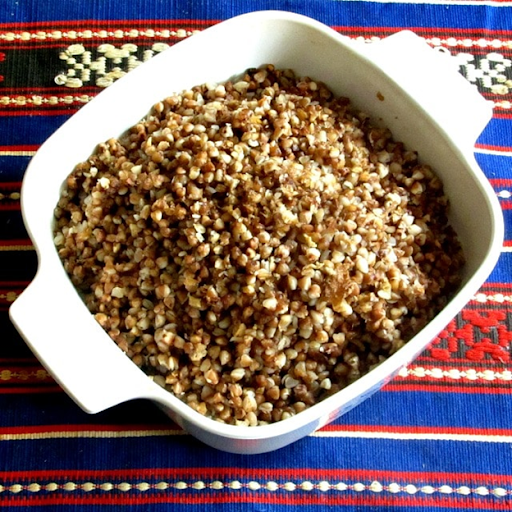
Visiting a bakery with Marshall Kaminer and Terri Kornicki
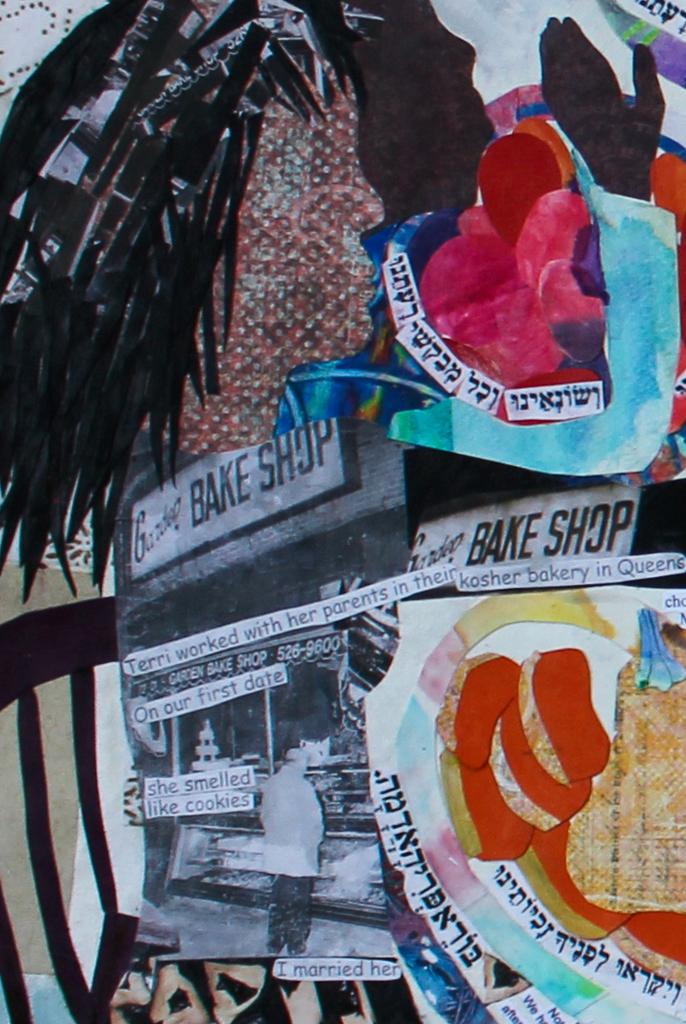
My own, my bride!
How much more delightful your love than wine,
Your ointments more fragrant
Than any spice! (11) Sweetness drops
From your lips, O bride;
Honey and milk
Are under your tongue;
And the scent of your robes
Is like the scent of Lebanon.
"Terri worked with her parents in their kosher in Queens.
On our first date she smelled like cookies.
I married her."
Rosh Hashanah Simanim
It has become traditional in many communities to hold Rosh Hashanah "seders" where one eats special foods, using word play based on the names or tastes of the foods to create blessings.
The most famous one is apples and honey for a sweet new year.
Below are some depictions of the simanim in the artwork:
Leeks - כרתי - kartei
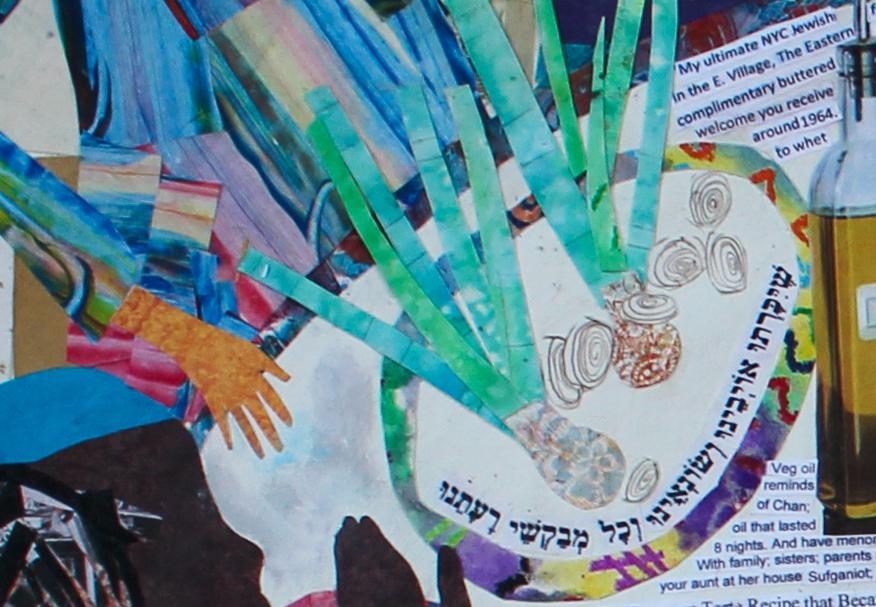
May it be your will, Lord our God and God of our ancestors that our enemies and haters will be cut (yikartu) off along with their evil plans.
(Yikartu, from the root k-r-t, sounds like the Rabbinic Hebrew word for leek: karti.)
Peas/Beans/Fenugreek - רוביאֿ/לוביא - Rubya/Lubya
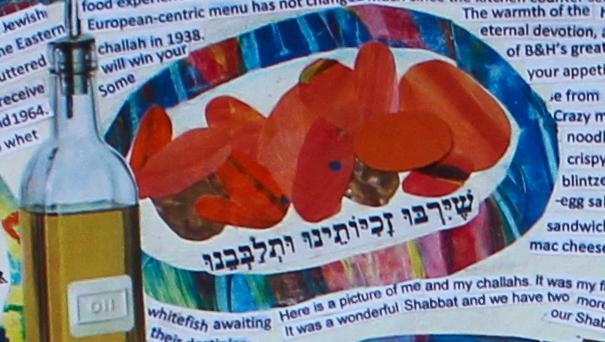
יְהִי רָצוֹן מִלְּפָנֶֽיךָ יְהֹוָה אֱלֹהֵינוּ וֵאלֹהֵי אֲבוֹתֵינוּ, שֶׁיִּרְבּוּ זְכֻיּוֹתֵינוּ וּתְלַבְּבֵנוּ:
May it be your will, Lord our God and God of our ancestors that our merits will increase (yirbu) and you will hearten us.
(Yirbu, from the root r-b-h, sounds like the Rabbinic Hebrew word for small legumes: rubya. Rubya also sounds like lubya, a Rabbinic Hebrew word for heart.)
Dates - תמרים - Tamarim
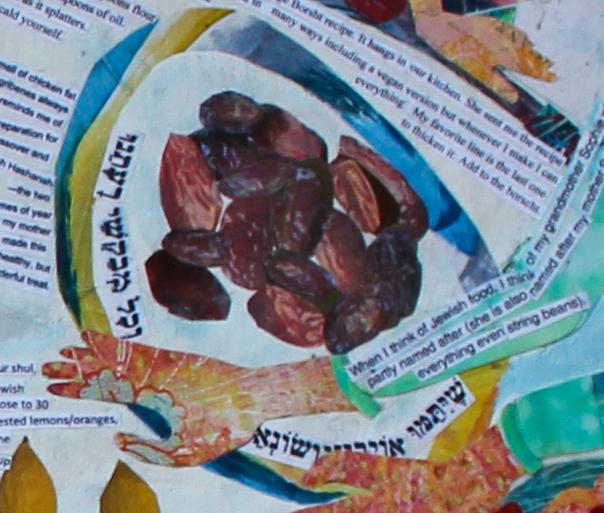
יְהִי רָצוֹן מִלְּפָנֶֽיךָ יְהֹוָה אֱלֹהֵינוּ וֵאלֹהֵי אֲבוֹתֵינוּ, שֶׁיִּתַּמּוּ אוֹיְבֶֽיךָ וְשׂוֹנְאֶֽיךָ וְכָל־מְבַקְשֵׁי רָעָתֵנוּ.
May it be your will, Lord our God and God of our ancestors that our enemies and haters will be ended (yitammu) along with their evil plans.
(Yitammu, which comes from tamam (finished) sounds like the Hebrew word for date: tamar.)
Pomegranate - רימון - Rimon
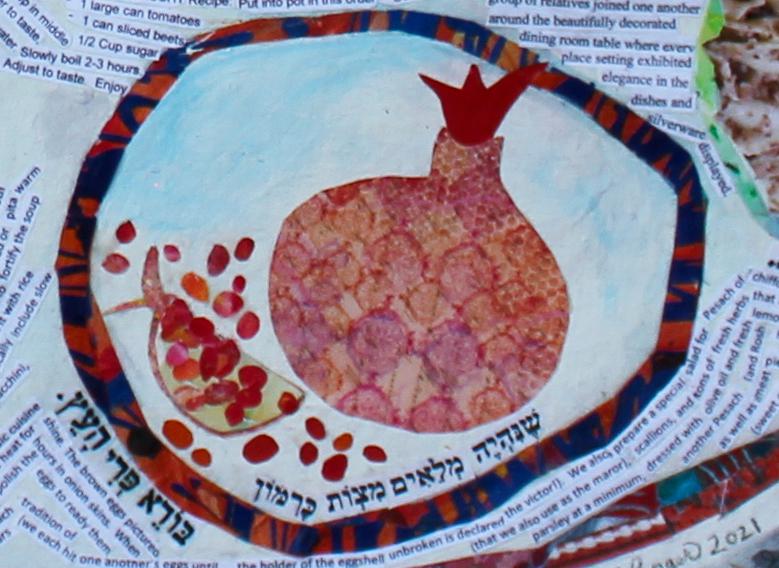
May it be your will, Lord our God and God of our ancestors that we will be as full of mitzvot as a pomegranate (is full of seeds).
Head of a fish - ראש דג - Rosh Dag
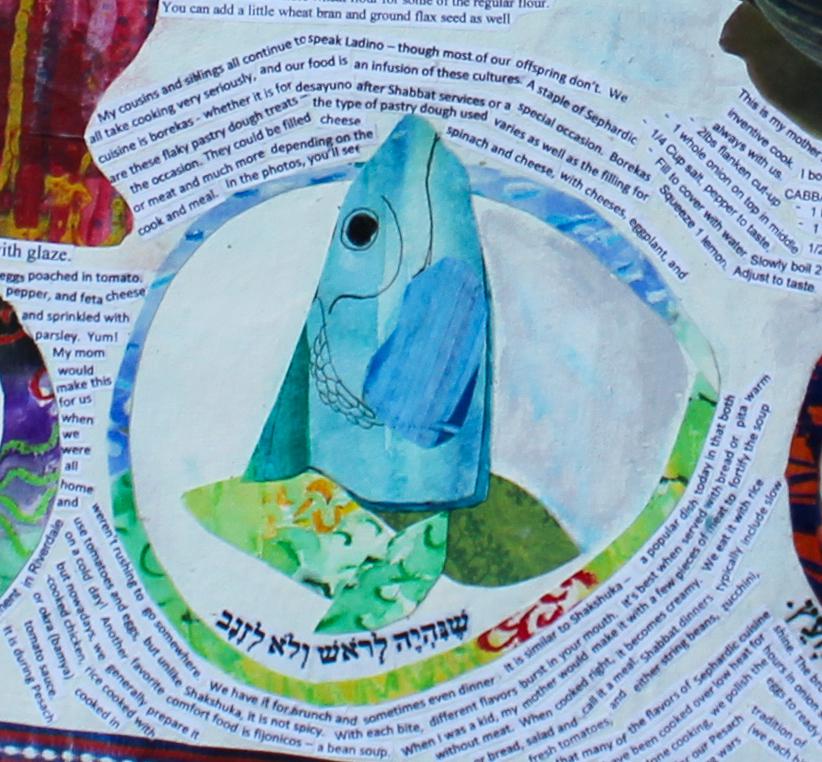
יְהִי רָצוֹן מִלְּפָנֶֽיךָ יְהֹוָה אֱלֹהֵינוּ וֵאלֹהֵי אֲבוֹתֵינוּ, שֶׁנִּהְיֶה לְרֹאשׁ וְלֹא לְזָנָב.
May it be your will, Lord our God and God of our ancestors that we will be the head and not the tail!
Apples and honey - תפוח בדבש - Tapuach b'dvash
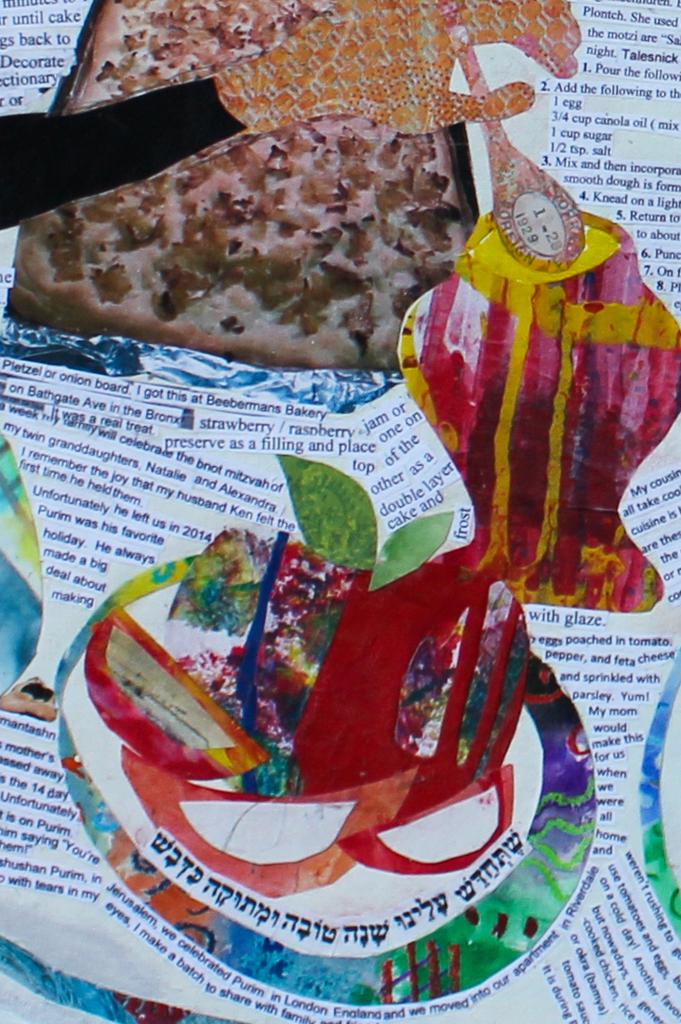
יְהִי רָצוֹן מִלְּפָנֶֽיךָ יְהֹוָה אֱלֹהֵינוּ וֵאלֹהֵי אֲבוֹתֵינוּ, שֶׁתִּתְחַדֵּשׁ עָלֵינוּ שָׁנָה טוֹבָה וּמְתוּקָ:
May it be your will, God, and God of our ancestors that you will renew us for a good and sweet year.
Carrot - גזר - gezer and gourd - קרא - kara
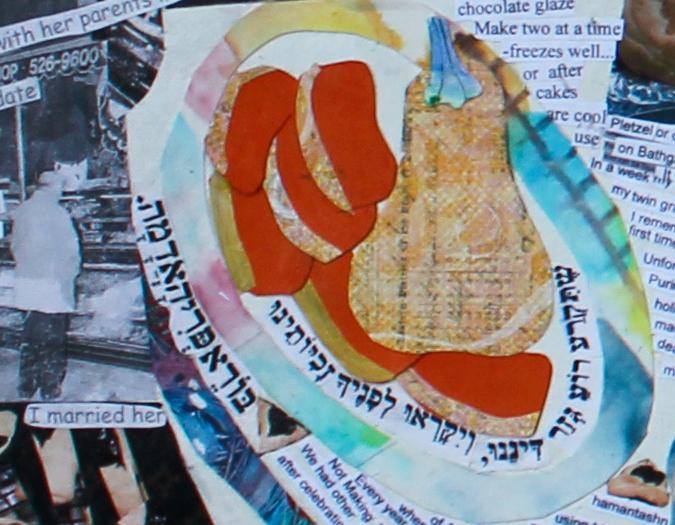
May it be your will, God, and God of our ancestors that you will tear up (tikroa) evil verdicts (g'zar) against us and call upon our merits before you.
("To tear" comes from a root that sounds like the Hebrew word for gourd: kara. Verdict or decree - g'zar - sounds like the Hebrew word for carrot: gezer. Additionally, a pile of sliced up carrots look like coins, a hope for prosperity in the coming year.)
Beet - סלק - selek
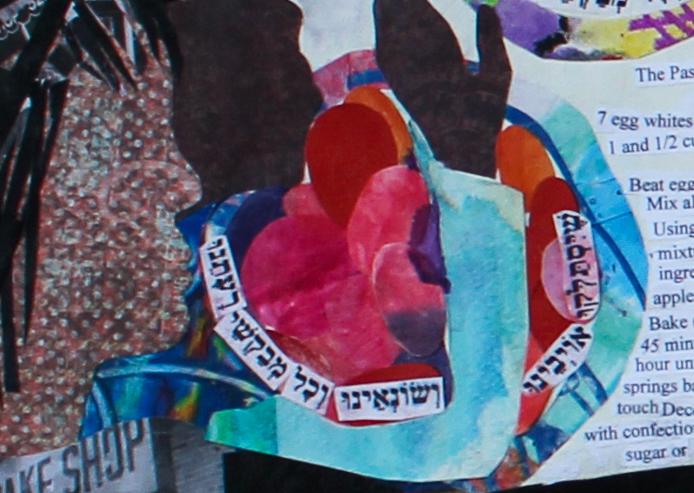
יְהִי רָצוֹן מִלְּפָנֶֽיךָ יְהֹוָה אֱלֹהֵינוּ וֵאלֹהֵי אֲבוֹתֵינוּ, שֶׁיִּסְתַּלְּקוּ אוֹיְבֶֽיךָ וְשׂוֹנְאֶֽיךָ וְכָל־מְבַקְשֵׁי רָעָתֵנוּ.
May it be your will, Lord our God and God of our ancestors that our enemies and haters will be finished (yistalku) along with their evil plans.
(Yistalku comes from the root s-l-k which means to finish and sounds like the Hebrew word for beet: selek.)


